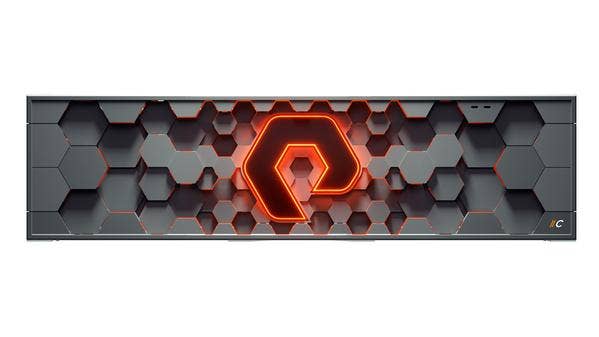Pure Storage Goes Wide On Flash: Intros Optane-Based Modules For Performance, QLC For Capacity
The new DirectMemory Modules combine Intel Optane with Pure Storage's DirectMemory Cache software to target performance-intensive applications, while its new QLC-based FlashArray//C brings flash to applications where performance is not key.

Pure Storage Tuesday expanded its all-flash storage array line into two different directions with the introduction of new memory modules to increase performance and the introduction of a new line featuring low-cost flash technology optimized for capacity.
The dual expansion of Pure Storage's flash technology helps the vendor and its channel community reach a wider range of customers than ever before, said Matt Kixmoeller, vice president of strategy for the Mountain View, Calif.-based company.
"It's the next step in the evolution of memory technology that has been going on for the last 10 years," Kixmoeller told CRN.
[Related: Pure Storage: Innovation, Channel Partners Key To 28 Percent Revenue Growth Year Over Year]
The expansion of Pure Storage's all-flash storage arrays was unveiled at the company's Pure Accelerate 2019 conference, being held this week in Austin, Texas. Pure Storage also used the conference to introduce additional artificial intelligence capabilities for its AIRI platform designed in conjunction with Nvidia and an expansion of its cloud capabilities to multi-cloud environments.
New to the company is the Pure Storage DirectMemory Modules, a series of modules that combines Pure Storage's DirectMemory Cache software and Intel Optane storage-class memory.
The DirectMemory Modules plug directly into the company's FlashArray//70 and FlashArray//90 flagship high-performance all-flash arrays to give application such as online transaction processing and online analytical processing a big performance boost by cutting storage latency by between 25 percent and 50 percent and reducing CPU utilization by up to 25 percent, Kixmoeller said.
Pure Storage FlashArray//70 and FlashArray//90 already take advantage of the company's DirectMemory Cache software for a reduced latency of up to 50 percent to accelerate mission-critical applications, Kixmoeller said. The software allows the DirectMemory Modules to plug into the existing arrays and be immediately available to boost the performance even higher, he said.
"The DirectMemory Modules can slot right into the FlashArrays to provide an immediate performance boost," he said. "There's no configuration needed. It acts like a read cache for the arrays. Eighty percent of arrays will get at least a 20 percent lower latency, and 40 percent will get a 30 [percent] to 50 percent lower latency. The modules also increase bandwidth. But latency is the key metric in database performance."
Kixmoeller said customers and partners can expect two major benefits from the DirectMemory Modules.
"First, it makes everything faster," he said. "Second, it speeds up the server tier. For example, SAP HANA can run in host memory or on the DirectMemory Modules. With the DirectMemory Modules, users get 90 percent of the performance of host memory, but with a 65 percent less expensive price."
Pure Storage also introduced a new capacity-optimized addition to its FlashArray family, the FlashArray//C, which is targeted at building the all-flash data center.
That all-flash data center until now has not been economically viable because of the cost of flash memory, Kixmoeller said. Pure Storage is changing that with the FlashArray//C, which he said takes advantage of low-cost QLC flash to make the industry's first capacity-optimized all-flash array.
"Our architecture talks to raw memory, so it's easy for us to work with QLC flash," he said. "We're using the FlashArray//C to go after the large-scale tier-two data. A lot of companies are buying midsize arrays for this. We can consolidate that capacity to a smaller footprint."
The FlashArray//C offers all the reliability and flash storage services customers are getting with Pure Storage's other all-flash arrays, Kixmoeller said. The only difference is in the performance and the cost, he said.
"Our FlashArray//X offers performance in the hundreds of microseconds range," he said. "The FlashArray//C is in the 2-millisecond to 4-millisecond range. So that’s a five-time to 10-time performance difference in terms of latency."
The FlashArray//C starts with a minimum capacity of 1 Petabyte, and scales to up to 5 Petabytes in a 9U footprint.
It is expected to be used in a wide range of applications now done by hard drive-based storage, including lower-cost disaster recovery and convenient test/dev applications, Kixmoeller said.
"We expect to see it used with VM tiering in the data center," he said. "A lot of all-flash arrays are used for VM management. VMware has management tools to migrate VMs. Customers can use their VMware storage policy-based management tools to discover their FlashArray//X and FlashArray//C based on those arrays' performance, and automatically move high-performance applications to the FlashArray//X and lower-performance applications to the FlashArray//C using vMotion."
Mark Gonzalez, regional vice president of sales at ePlus, a Herndon, Va.-based solution provider and Pure Storage channel partner, told CRN that the new FlashArray//C is a game-changer.
Customers are looking for the reliability, lower power consumption, and performance of flash at a lower cost than disk storage, and Pure is starting to provide it, Gonzalez said.
"When I worked for a storage vendor in the past, we used to say disks did three things: read, write and break," he said. "But if customers can read and write reliably at a lower cost without breaking, why not use flash?"
Both the DirectMemory Modules and the FlashArray//C are available starting this week.